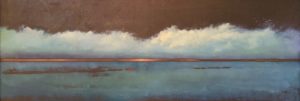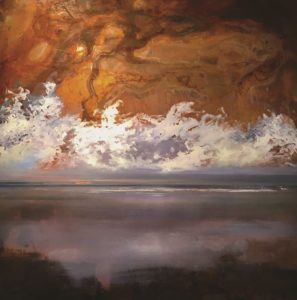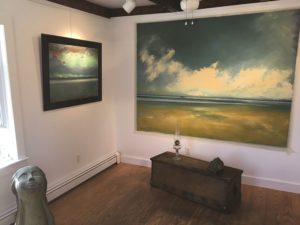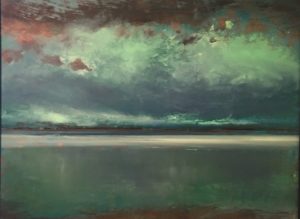The first piece of copper that Michael Marrinan sold didn’t have much paint on it. The sheet — a scrap from a copper bar top he’d built for the Underground in Provincetown around 2008 — had been aging in his driveway all winter. By spring, oxidation had worn oyster-shaped rings around two trash bins sitting on it through the rain and snow. Marrinan removed the bins, and inspiration struck. He cleaned up the lines with some white paint, framed it, and sold “The Copper Oyster” the very same day.

“The copper points me in different directions,” Marrinan says from his Wellfleet gallery. Unlike linen, the metal doesn’t absorb paint, so colors stay especially brilliant. Before painting, Marrinan treats it with organic tomatoes or sulfur to enhance its natural patina — the layer of tarnish that forms when copper touches certain elements. Green tarnish makes for a striking cloudburst. Orange contrasts with the soft blues of the sea and sky. Sometimes, after the paint has dried, Marrinan scrapes some off with sandpaper or a chisel to evoke light reflecting off the water.
The light is what made Marrinan fall in love with Cape Cod. He first visited at the suggestion of a Boston friend and moved here in 1999. Before then, he had lived in Spain, France, and Thailand for a few years at a time. He recalls driving down Wellfleet’s Commercial Street one day about four years ago, while he was showing at Left Bank Gallery. The sun shone through the snow clouds as the white flakes came down. With a cup of coffee in hand, he headed to the beach to witness the rare scene over the ocean. Soon after, he rented the space for Marrinan Gallery at 14 Commercial St.

Marrinan has been painting his whole life. Born in London to Irish parents, he was accepted to the Chelsea College of Arts in London after finishing his high school requirements at 15. But there was a catch: he’d have to wait until he was 18 to start at the university. By that time, Marrinan had already learned plenty from experience. He spent his late teens and early 20s laying brick and restoring churches in England.
Marrinan remembers looking at piles of rusty doorknockers, old steel, and other worn-out materials. “When they’re four or five hundred years old, you don’t throw anything away,” he says. “You just manipulate them in another way and build them back into the church in a way that’s more useful.” This waste-nothing mentality can be seen in his current work. He transforms scrap sheets of metal from various projects — including bars, kitchens, and bathrooms —into paintings.

While copper’s smooth, anti-bacterial surface is handy for a bathroom, it poses challenges for a painter. “I can leave the studio thinking I’ve just started a Picasso,” says Marrinan. He might return the next day and realize he’s added too much linseed oil thinner, “so it’s all just dripped into the middle and you have this goop,” he says.
Too much varnish — the paint will crack. Air too humid — the paint won’t adhere. Copper too hot on a summer day — the paint will melt off before it even thinks about drying. “There are still things I’m trying to work out,” Marrinan says. “It’s a process rather than a formula.”

Marrinan isn’t keen on the starving artist lifestyle. “People ask, ‘What’s your greatest motivation?’ and I always say ‘success.’ ” He plans on spending his winter recovering from this far-busier-than-usual season. Between finishing commissions at his studio in Eastham, he might rebuild some chimneys. Though Marrinan considers himself a painter first, he has been experimenting with sculpture, too.
“That just comes back to the days I’ve been a bricklayer,” he says. The quiet Cape winter is his ideal backdrop for creating, building, and experimenting.
